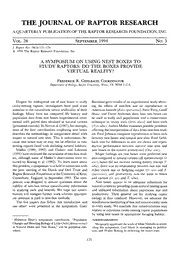
A SYMPOSIUM ON USING NEST BOXES TO STUDY RAPTORS - DO THE BOXES PROVIDE VIRTUAL-REALITY PDF
Preview A SYMPOSIUM ON USING NEST BOXES TO STUDY RAPTORS - DO THE BOXES PROVIDE VIRTUAL-REALITY
THE JOURNAL OF RAPTOR RESEARCH A QUARTERLY PUBLICATION OF THE RAPTOR RESEARCH FOUNDATION, INC. VOL. 28 September 1994 No. 3 J Raptor Res. 2%{y):\25-\2() © 1994 The Raptor Research Foundation, Inc. A SYMPOSIUM ON USING NEST BOXES TO STUDY RAPTORS: DO THE BOXES PROVIDE VIRTUAL REALITY? Frederick R. Gehlbach, Coordinator TX Department ofBiology, Baylor University, Waco, 76798 US.A. Despite the widespread use of nest boxes to study Bortolotti gives results of an experimental study show- cavity-nesting raptors, investigators have paid scant ing the effects of nest-box size on reproduction in attention to the naturalness versus artificiality of their American kestrels {Falco sparverius). Steve Petty, Geoff findings. Many have not compared life history and Shaw, and David Anderson show how nest boxes can population data from nest boxes (experimental treat- be used to study owl populations and a conservation ments) with paired data obtained at natural cavities technique in tawny owls {Strix aluco) and barn owls (presumed controls). In Nero et al. (1987), for example, (Tytoalba). Anders Moller examines possible problems none of the four contributions employing nest boxes affecting the interpretation of data from nest-box stud- describes the methodology in comparative detail with ies. Paul Johnson compares reproduction in barn owls respect to natural nest sites. This is unfortunate, be- between nest boxes and natural nest sites. Fred Gehl- cause nest boxes may or may not be effective in con- bach tests for differences in nest site choice and repro- serving raptors faced with declining natural habitats. ductive performance between natural nest sites and Mpller (1989, 1992) and Clobert and Lebreton nest boxes in the eastern screech-owl {Otus asio). (1991) have criticized the naturalness ofnest-box stud- Major findings are that boxes were preferred nest ies, although some of Moller’s observations were re- sites compared to natural cavities (all species except O. butted by Koenig et al. (1992). To learn more about asio), boxes did not increase nesting density (except T this problem, a symposium was held in connection with alba), there was no relationship between box size and the joint meeting of the Hawk and Owl Trust and either clutch size or fledgling output (O. asio and F Raptor Research Foundation at the University ofKent, sparverius), and productivity was the same in boxes Canterbury, England, in September 1993. The sym- and cavities (O. asio and T. alba). posium was designed to answer questions about the Nest boxes appear to be adequate substitutes for validity of nest-box versus natural-cavity information natural cavities by providing quasi-natural nesting space We in studying owls and kestrels. hope our contri- and unbiased information about population size and butions will instigate further work wherein appropri- productivity. Their general use for studying raptor ate attention is paid to nest-box methods. biology is thus validated. However, we advocate the The five papers that follow this introduction and simultaneous monitoring ofbox and natural-cavity nests We one other' were presented at the symposium. Gary in every study. conclude that conservationists may replace or rejuvinate cavity-nesting raptor populations by using nest boxes in appropriate foraging habitat. ' Hubertus Illner’s symposium contribution, “Population Acknowledgments Changes and Breeding Biology ofLittle Owls {Athene noctua) We greatly appreciate the work ofMike Nicholls in sched- m Natural Holes and Nest Boxes,” will be published else- uling this symposium, Carl Marti in managing its publica- where. tion, and Walter Koenig in reviewing the entire copy. 125 126 Frederick R. Gehlbagh VoL. 28, No. 3 Literature Cited Moller, A.P. 1989. Parasites, predators and nest boxes; facts and artefacts in nest box studies of birds? Oikos 56- Clobert, J. and J.D. Lebreton. 1991. Estimation of 421-423. demographic parameters in bird populations. Pages 75- 1992. Nest boxes and the scientific rigour of ex- 104 in C.M. Perrins, J-D. Lebreton, and G.J.M. Hirons . perimental studies. Oikos 63:309-311. a[Endds.]m,anBaigredmpeonptu.latOixofnorsdtudUinesi:v.rePlreevsasn,ceNteowcoYnoserrkv,atNioYn Nero, R.W., R.J. Clark, R.J. Knapton and R.H. Hamre [Eds.]. 1987. Biology and conservation of northern for- U.S.A. Koenig, W.D., P.A. Gowaty and J.L. Dickinson. 1992. est owls. Gen. Tech. Rep. RM-142, Rocky Mountain Forest and Range Exp. Sta., U.S. Forest Serv., Ft. Collins, Boxes, barns, and bridges: confounding factors or excep- CO U.S.A. tional opportunities in ecological studies. Oikos 63:305- 308.
